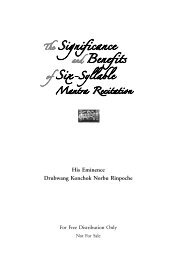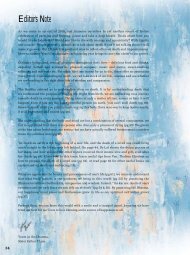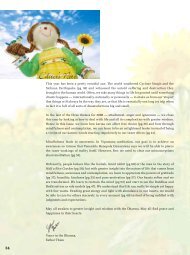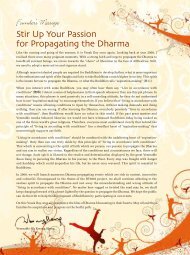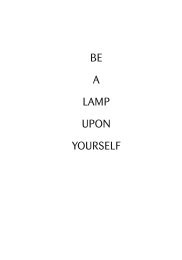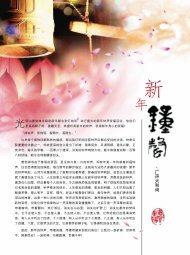Awaken16 - Kong Meng San Phor Kark See Monastery
Awaken16 - Kong Meng San Phor Kark See Monastery
Awaken16 - Kong Meng San Phor Kark See Monastery
You also want an ePaper? Increase the reach of your titles
YUMPU automatically turns print PDFs into web optimized ePapers that Google loves.
The Buddha taught us to give up all forms of evil<br />
and cultivate virtue. This is the right path. Teaching<br />
in this way is like the Buddha picking us up and<br />
placing us at the beginning of the path. Having<br />
reached the path, whether we walk along it or not<br />
is up to us. The Buddha's job is finished right there.<br />
He shows the way, that which is right and that<br />
which is not right. This much is enough, the rest is<br />
up to us.<br />
Now, having reached the path we still don't know<br />
anything, we still haven't seen anything, so we<br />
must learn. To learn we must be prepared to endure<br />
some hardship, just like students in the world.<br />
It's difficult enough to obtain the knowledge and<br />
learning necessary for them to pursue their careers.<br />
They have to endure. When they think wrongly or<br />
feel averse or lazy they must force themselves before<br />
they can graduate and get a job. The practice for a<br />
monk is similar. If we are determined to practise<br />
and contemplate, then we will surely see the way.<br />
Ditthi-mana - is a harmful thing. Ditthi means<br />
“view” or “opinion”. All forms of view are called<br />
ditthi: seeing good as evil, seeing evil as good... any<br />
way whatsoever that we see things. This is not the<br />
problem. The problem lies with the clinging to those<br />
views, called mana;<br />
-<br />
holding on to those views as if<br />
they were the truth. This leads us to spin around<br />
from birth to death, never reaching completion, just<br />
because of that clinging. So the Buddha urged us to<br />
let go of views.<br />
If many people live together, as we do here, they<br />
can still practise comfortably if their views are in<br />
harmony. But even two or three monks would have<br />
difficulty if their views were not good or harmonious.<br />
When we humble ourselves and let go of our views,<br />
even if there are many of us, we come together at the<br />
Buddha, Dhamma and <strong>San</strong>gha (the Monastic Order,<br />
or those who have realised the Dhamma).<br />
It's not true to say that there will be disharmony just<br />
because there are many of us. Just look at a millipede.<br />
A millipede has many legs, doesn't it? Just looking<br />
at it you'd think it would have difficulty walking,<br />
but actually it doesn't. It has its own order and<br />
rhythm. In our practice it's the same. If we practise<br />
as the Noble <strong>San</strong>gha of the Buddha practised, then<br />
it's easy. That is, supatipanno - those who practise<br />
well; ujupatipanno - those who practise straightly;<br />
ñayapatipanno -<br />
- those who practise to transcend<br />
suffering, and samıcipatipanno<br />
-<br />
- those who practise<br />
properly. These four qualities, established within<br />
us, will make us true members of the <strong>San</strong>gha. Even<br />
if we number in the hundreds or thousands, no<br />
matter how many we are, we all travel the same<br />
path. We come from different backgrounds, but we<br />
are the same.<br />
Even though our views may differ,<br />
if we practise correctly there will be<br />
no friction. Just like all the rivers and<br />
streams which flow to the sea... once<br />
they enter the sea they all have the<br />
same taste and colour. It's the same with<br />
people. When they enter the stream<br />
of Dhamma, it's the one Dhamma.<br />
Even though they come from different<br />
places, they harmonise, they merge.<br />
But the thinking which causes all the<br />
disputes and conflict is ditthi-mana.<br />
-<br />
Therefore the Buddha taught us to let<br />
go of views. Don't allow mana<br />
-<br />
to cling<br />
to those views beyond their relevance.<br />
The Buddha taught the value of constant sati,<br />
recollection. Whether we are standing, walking,<br />
sitting or reclining, wherever we are, we should<br />
have this power of recollection. When we have sati<br />
we see ourselves, we see our own minds. We see<br />
the “body within the body”, “the mind within the<br />
mind”. If we don't have sati we don't know anything,<br />
we aren't aware of what is happening.<br />
So sati is very important. With constant sati we will<br />
listen to the Dhamma of the Buddha at all times.<br />
This is because “eye seeing forms” is Dhamma;<br />
“ear hearing sounds” is Dhamma; “nose smelling<br />
odours” is Dhamma; “tongue tasting flavours” is<br />
Dhamma; “body feeling sensations” is Dhamma;<br />
when impressions arise in the mind, that is Dhamma<br />
also. Therefore one who has constant sati always<br />
hears the Buddha's teaching. The Dhamma is always<br />
there. Why? Because of sati, because we are aware.<br />
Issue 16 • January – April 2010 55<br />
Do You Know...<br />
awaken





